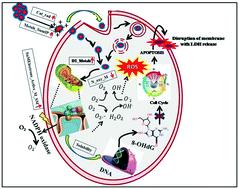当前位置:
X-MOL 学术
›
Environ. Sci.: Nano
›
论文详情
Our official English website, www.x-mol.net, welcomes your feedback! (Note: you will need to create a separate account there.)
Assessment of toxicity of metal oxide and hydroxide nanoparticles using the QSAR modeling approach
Environmental Science: Nano ( IF 7.3 ) Pub Date : 2021-10-01 , DOI: 10.1039/d1en00733e Joyita Roy 1 , Kunal Roy 1
Environmental Science: Nano ( IF 7.3 ) Pub Date : 2021-10-01 , DOI: 10.1039/d1en00733e Joyita Roy 1 , Kunal Roy 1
Affiliation

|
Nowadays, nanotechnology is a promising area of research. Therefore, a detailed understanding of comprehensive risk assessment of nanomaterials and their behavior to the biological system is required before working with any metallic oxide (hydroxide) nanoparticles (MeOx NPs). Empirical testing of all toxicity endpoints of MeOx NPs is impossible with limited resources; therefore, an efficient alternative method complementary to experimentation is very essential. Quantitative structure–activity relationship (QSAR) models are widely adopted to predict the toxicity of untested nanomaterials. In the present study, QSAR models were developed to computationally evaluate the cytotoxicity of MeOx NPs towards RAW 264.7 cells. Both MLR and PLS models were developed with 25 NPs (nanoparticles) from 6 metal (hydro) oxide families (SiO2, TiO2, CeO2, AlOOH, ZnO, and Ni(OH)2) using the release of lactate dehydrogenase (ldhR) from the cell as the endpoint. Multiple linear regression (MLR) models were developed using the best subset selection method followed by enhancement of model derived predictions by the application of the intelligent consensus predictor (ICP) tool. On the other hand, a partial least squares (PLS) model was developed using the Small Dataset Modeler software which can handle a limited number of data points. Periodic table descriptors and some physicochemical descriptors have been used to characterize the nanostructure of MeOx NPs. All models were validated meticulously by employing internal and external validation metrics followed by the randomization test and applicability domain (AD) study. The statistical metric values suggested the robustness of the models. The insights from both models suggested that electronegativity, solubility, formation of a metal cation increase the cytotoxicity whereas non-metal NPs and an increase of the oxidation degree contribute to low toxicity towards RAW 264.7 cells. A short proposed mechanism has also been explained to determine the cause of cellular toxicity by the MeOx NPs.
中文翻译:

使用 QSAR 建模方法评估金属氧化物和氢氧化物纳米粒子的毒性
如今,纳米技术是一个很有前途的研究领域。因此,在使用任何金属氧化物(氢氧化物)纳米粒子(MeOx NP)之前,需要详细了解纳米材料的综合风险评估及其对生物系统的行为。由于资源有限,不可能对 MeOx NP 的所有毒性终点进行实证测试;因此,一种补充实验的有效替代方法是非常必要的。定量构效关系(QSAR)模型被广泛用于预测未经测试的纳米材料的毒性。在本研究中,开发了 QSAR 模型以计算评估 MeOx NPs 对 RAW 264.7 细胞的细胞毒性。MLR 和 PLS 模型均使用来自 6 个金属(氢)氧化物家族 (SiO 2、TiO 2、CeO 2、AlOOH、ZnO 和 Ni(OH) 2 ) 使用乳酸脱氢酶 (ldh R) 从单元作为端点。多元线性回归 (MLR) 模型是使用最佳子集选择方法开发的,然后通过应用智能共识预测器 (ICP) 工具增强模型得出的预测。另一方面,偏最小二乘 (PLS) 模型是使用 Small Dataset Modeler 软件开发的,该软件可以处理有限数量的数据点。元素周期表描述符和一些物理化学描述符已被用于表征 MeOx NPs 的纳米结构。通过采用内部和外部验证指标,然后是随机化测试和适用性域 (AD) 研究,对所有模型进行了精心验证。统计指标值表明模型的稳健性。来自两个模型的见解表明电负性、溶解度、金属阳离子的形成增加了细胞毒性,而非金属 NPs 和氧化度的增加有助于降低对 RAW 264.7 细胞的毒性。还解释了一个简短的建议机制,以确定 MeOx NP 引起细胞毒性的原因。
更新日期:2021-10-20
中文翻译:

使用 QSAR 建模方法评估金属氧化物和氢氧化物纳米粒子的毒性
如今,纳米技术是一个很有前途的研究领域。因此,在使用任何金属氧化物(氢氧化物)纳米粒子(MeOx NP)之前,需要详细了解纳米材料的综合风险评估及其对生物系统的行为。由于资源有限,不可能对 MeOx NP 的所有毒性终点进行实证测试;因此,一种补充实验的有效替代方法是非常必要的。定量构效关系(QSAR)模型被广泛用于预测未经测试的纳米材料的毒性。在本研究中,开发了 QSAR 模型以计算评估 MeOx NPs 对 RAW 264.7 细胞的细胞毒性。MLR 和 PLS 模型均使用来自 6 个金属(氢)氧化物家族 (SiO 2、TiO 2、CeO 2、AlOOH、ZnO 和 Ni(OH) 2 ) 使用乳酸脱氢酶 (ldh R) 从单元作为端点。多元线性回归 (MLR) 模型是使用最佳子集选择方法开发的,然后通过应用智能共识预测器 (ICP) 工具增强模型得出的预测。另一方面,偏最小二乘 (PLS) 模型是使用 Small Dataset Modeler 软件开发的,该软件可以处理有限数量的数据点。元素周期表描述符和一些物理化学描述符已被用于表征 MeOx NPs 的纳米结构。通过采用内部和外部验证指标,然后是随机化测试和适用性域 (AD) 研究,对所有模型进行了精心验证。统计指标值表明模型的稳健性。来自两个模型的见解表明电负性、溶解度、金属阳离子的形成增加了细胞毒性,而非金属 NPs 和氧化度的增加有助于降低对 RAW 264.7 细胞的毒性。还解释了一个简短的建议机制,以确定 MeOx NP 引起细胞毒性的原因。



























 京公网安备 11010802027423号
京公网安备 11010802027423号